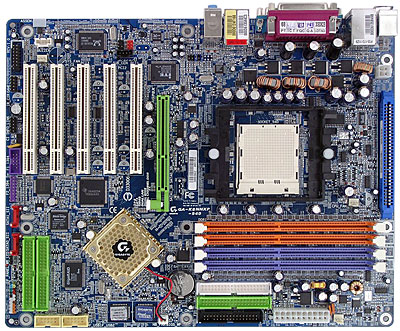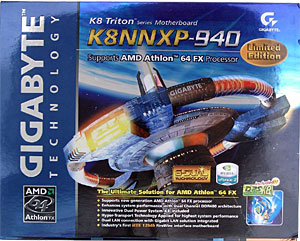Gigabyte K8NNXP-940 motherboard on NVIDIA nForce3
Pro 150
|
The board has a comprehensive bundle and functionality – an excellent example of a top-end product.

The circuitry is usual – the number of sockets is not very comfortably located along the left border; audio connectors are located in front of PCI slots, IDE RAID sockets – behind them, while the overcrowded memory sockets prevents free access to them. The access to jumper can be problematic during the motherboard installation. The brief board description is provided on PCB. Available voltage is indicated by a yellow LED. Besides, another LED is lit when you try to install a +3.3V graphics card prohibited for this board. The tri-channel switching voltage regulator features 6 x 3300µf and 4 x 1500µf capacitors. The board also has a Gigabyte DPS socket for additional VRM module. There are also AGP (4 x 1000µf and some smaller capacitors) and memory (6 x 1000µf) voltage regulators.
The board has no unsoldered circuitry. Its size is 305x245mm (full ATX, 9-screw mount, firm fixation). ITE IT8712F-A chip is used to monitor:
- CPU, memory, +3.3V, +12V voltage;
- Rpm of 2 fans;
- CPU and motherboard temperatures (using corresponding sensors).
Onboard ports, connectors and sockets:
- CPU Socket 940;
- 4 x DDR SDRAM DIMM (in couples, distinguished by color);
- 1 x AGP (with a latch);
- 5 x PCI;
- Standard ATX power and 4-pin 12V;
- 1 x FDD;
- 4 x IDE (Parallel ATA) - 2 in the chipset, 2 on the additional
controller;
- 2 x SATA RAID (Serial ATA) on the additional controller;
- 2 x USB (2.0) headers;
- 1 x Game;
- 2 x headers for 2 x GigaWire each (FireWire-800, IEEE 1394b);
- 1 x CD/DVD Audio connector;
- 1 x AUX-IN;
- 1 x modem audio connector;
- 1 x IrDA;
- 1 x SMBus;
- A header for additional audio connectors and S/PDIF;
- 4 x cooler connectors (3 with rpm control, 1 uncontrolled chipset
heatsink fan).
Backpanel (left to right blockwise)

- PS/2 mouse and keyboard;
- 1 x RJ-45 (Ethernet);
- 1 x LPT and 2 x COM;
- 2 x USB and RJ-45 (Gigabit Ethernet);
- Mic-In, Line-In, Front.
Bundle

- A standard box;
- Manual: user’s guide, IDE RAID guide, SATA RAID guide, quick start
guide; all in English;
- 3 x ATA66/100/133, 1 x FDD, 2 x SerialATA cables;
- Backpanel strap for external SATA devices (with power adapter);
- Backpanel strap with 4 x USB;
- Backpanel strap with 2 x FireWire-800;
- Backpanel strap with Center/Sub, Rear, S/PDIF-Out (TosLink and
Coaxial);
- Gigabyte DPS module;
- Backpanel stub;
- Software CD:
- Motherboard drivers;
- Adobe Acrobat Reader;
- DirectX 9.0;
- Norton Internet Security;
- Gigabyte @BIOS;
- Gigabyte DMIView;
- Gigabyte EasyTune4;
- Gigabyte FaceWizard;
- Gigabyte Windows Utility Manager;
- Gigabyte IA Panel;
- Gigabyte Management Tools;
- Gigabyte System Information Viewer.
Integrated controllers
- Avance Logic ALC658 AC'97 5.1 audio codec with front audio inputs/outputs
connector and S/PDIF;
- 2 x LAN: Realtek RTL8201BL supporting 10/100Mbps with Base-T
(Fast Ethernet) and Realtek RTL8110S-32 supporting 10/100/1000Mbps
with Base-T (Gigabit Ethernet);
- GigaWire (FireWire-800, IEEE 1394b) on Texas Instruments TSB82AA2
and TSB81BA3 supporting 2 ports;
- IDE RAID on ITE IT8212F supporting up to 4 devices and RAID
0, 1, 0+1, JBOD;
- SATA RAID on Silicon Image SiI3512A supporting 2 x SATA and
RAID 0, 1.
The integrated audio quality was tested in 16-bit, 44kHz mode using RightMark Audio Analyzer 5.2 and Terratec DMX 6fire:
| Frequency response
(from 40 Hz to 15 kHz), dB: |
+0.13, -0.20 |
Very good |
| Noise level,
dB (A): |
-88.6 |
Good |
| Dynamic range,
dB (A): |
88.1 |
Good |
| THD, %: |
0.0039 |
Very good |
| IMD, %: |
0.013 |
Very good |
| Stereo crosstalk,
dB: |
-90.0 |
Excellent |
Summary: Very good (details).
Proprietary technologies
- Gigabyte DualBIOS (BIOS backup Flash EEPROM chip);
- Gigabyte DPS (installed into the additional VRM socket).
Settings
| Jumpers and switches |
Password reset jumper |
|
| BIOS,
Award 6.00PG |
Memory timings |
+ |
CAS Latency, RAS
to CAS Delay, Min. RAS Active Time, Row Precharge Time, Refresh
Period, Row Cycle Time, Row Refresh Cycle Time, Row to Row Delay,
Write Recovery Time, Write to Read Delay, Read to Write Delay |
| Memory frequency
selection |
+ |
Auto, 100, 133,
150, 166, 200 MHz |
| AGP adjustment |
+ |
|
| PCI adjustment |
- |
|
| AGP and PCI divider
adjustment |
+ |
AGP(PCIx2)=66-100
MHz with 1MHz increments |
| Manual IRQ settings |
+ |
|
| Manual FSB frequency |
+ |
200-300 MHz with
1MHz increments |
| CPU multiplier |
+ |
x4-x24 |
| CPU core voltage |
+ |
Normal, 0.8-1.7V
with 0.025V increments up to 1.55V and 0.05V increments further |
| Memory voltage |
+ |
Normal, +0.1, +0.2,
+0.3 V |
| Chipset voltage |
+ |
Normal, +0.1, +0.2,
+0.3 V |
| AGP voltage |
+ |
Normal, +0.1, +0.2,
+0.3 V |
We used the F3 BIOS as the latest available at the moment of testing.
Test results:
Write a comment below. No registration needed!
|
|
 |
|
|
|



